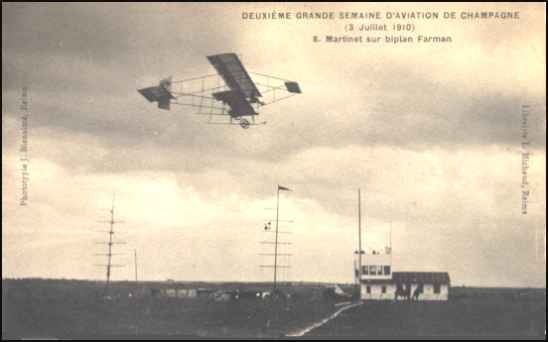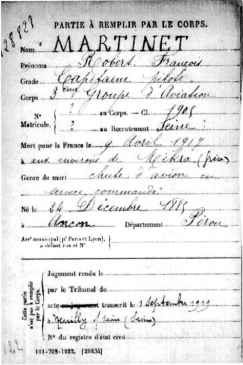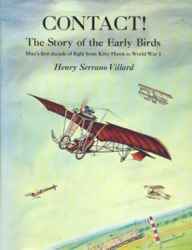
1885-1917 |
 |
ROBERT MARTINET ON HIS
SOMMER The first town-to-town race, between Augers and Saumur, France, June 6, 1910. "The photo shows Robert Martinet on his SOMMER (Roger Sommer). More likely the pilot is his good friend Georges Legagneux (who can’t be seen in this picture). Legagneux won a prize on Martinet’s Sommer during this air show." Michel Bénichou Le Fana de l’Aviation. Chief editor. |
|
From the book CONTACT by Henry Serrano Villard The Angers-Saumur race was conceived by an early aeronaut and pioneer experimenter in powered flight, Robert Marie Jules René Gasnier (born 1874)--who with his brother Píerre formed an inventive fraternal team like the Wrights, Farmans, Vloisins, and Telliers. Beginning in 1905, René Gasnier, an imposing man with a luxuriant black beard, had made balloon ascensions in various parts of Europe and the United States. Then, in 1908, the Gasnier brothers--tested a homemade aeroplane. With René in the pilot's seat, Píerre lay in the grass to observe whether the wheels of their pusher biplane, employing an Antoinette 50-hp motor, left the ground. Before his death in 1913, René not only staged the Angers-Saumur contest but two years later promoted the much more challenging Circuit of Anjou. Píerre, who became a pioneer civilian and military aviator, lives today at the family seat near Angers; in 1950 he was given the rank of commander in the Legion of Honor, for his services to French aviation. A monument to René overlooks the picturesque site along the river Loire where his first trials were conducted. At the start of the Anger-Saumur race, vagaries of the wind caused a long delay. More than two hundred thousand impatient spectators had gathered to witness the event. The Loire was jammed with boats, and the road with automobiles; pretty Red Cross nurses had taken up strategic stations to render first aid to anyone tumbling out of the blue. The trinational entry list of pilots and their machines read as follows; Emile Aubrun (Blériot), André Crochon (Henry Farman), Captain Bertram Dickson (Henry Farman), Georges Legagneux (Sommer), Robert Martinet (Henry Farman), the German Walter de Mumm (Antoinette), and Marcel Paillette (Sommer). Most of these flyers had received their pilots certificates only recently; their temerity in signing up for such a risky excursion led to cries of protest from the local press. as well as many others which can be found in the book. From CONTACT by Henry Serrano Villard |
 |
|
(3 Juliet 1910) 8. Martinet sur biplan Farman SECOND GREAT WEEK Of CHAMPAGNE AVIATION (July 3, 1910) 8. Martinet in his Farman Collection of Giovanni Giorgetti, 12-2-05 |
 |
|
|
via email from Dave Lam, 12-4-05 Robert Martinet earned his French wings 17 May 1910 in an H.Farman. He earned license # 78. Dave |
 |
|
From the Mémoire des hommes website. |
via email from Laurent Rastel, 11-7-07 About Robert Martinet : - birth date : 24 December 1885 (Peru) - death date : 9 April 1917 (died in flying accident at Micra airfield on Salonica Front). Following is a link in which those details are recorded : Congratulation for your very interesting website. Regards Laurent Editor's Note: I thank Laurent for this important, basic information. If you will click on the link above, you will see the official document, in French, which shows many more personal details of interest. The image can be enlarged by clicking on the cursor over the picture. |
|
"On June 6, In 1910... Robert Martinet wins the first cross-country air race, between Angers and Saumur, France (27 miles), in a Farman; he takes 31 minutes and 35 seconds." from "Editor-in-Chief: Bill Gunston, Aviation: Year by Year, Amber Books Limited, London, UK, 2001. |
|
|
|
Competing for the Grand Prize of the Aero club of France. (Source: The Air Review). |
|
No. 01 02 03 04 05 06 07 08 09 10 11 12 14 15 16 17 18 19 20 21 22 23 24 25 26 27 28 29 30 31 32 33 34 35 36 |
Pilot Gaubert Labouret Tabuteau Espanet Bedel Garros Hamel Brindejonc Bobba Renaux Bielovucic Allard Legagneux Hanouille Mouthiere Obre Audemars J Védrines Hélen Molla Wynmalen Wagner Frey Ehrmann Labouchére Renaux Laugarot Fischer Mesguich Vidart Verstraeten Pierre Béard Bielovucic Divétain Grazzioli |
Apparatus Astra Astra Morane-Salunier Nieuport Morane-Saulnier Blériot Blériot Morane-Saulnier Morane-Saulnier Farman Voisin Caudron Zens Blériot Morane-Saulnier Monoplan Blériot Deperdussin Nieuport REP Breguet Hanriot Hanriot Deperdussin Zodiac M Farman M Farman H Farman Morane-Saulnier Deperdussin Sommer Blériot De Marcay Ladougne Blériot |
Motor Renault 90 ch Renault 70 ch Gnome 80 ch Gnome 80 ch Gnome 80 ch Gnome 50 ch Gnome 80 ch Gnome 80 ch Gnome 80 ch Gnome 70 ch Antoinette 60 ch Anzani 100 ch Antoinette 50 ch Anzani 60 ch Gnome 80 ch GNome 70 ch Gnome 80 ch Gnome 100 ch Gnome 80 ch REP 75 ch Canton-U 80 ch Gnome 70 ch Gnome 70 ch Gnome 100 ch Clerget 100 ch Renault 90 ch Renault 70 ch Gnome 80 ch Gnome 80 ch Gnome 100 ch Anzani 60 ch Anzani 60 ch Anzani 100 ch Gnome 80 ch Anzani 60 ch |
|
René Allard flew his 1912 Caudron biplane propelled by the new
Anzani 100 star engine and carries the number 12. George Legagneux teams with Robert Martinet in the monoplane 1910 Paul Zens
monoplane with the antique Antoinette 50 engine, carrying the number 14 and with which he is not likely to finish the test. Let us note
the absence of number 13. Biélovucic gave up his heavy Voisin biplane and piloted the very new Marcay monoplane with an
Anzani engine of 100 CH. In consequence of the bad weather, the race was a catastrophe. Allard destroyed his biplane on the takeoff, as did Biélovucic. Bedel made a "wooden horse" on takeoff; Hélen and the Legagneux-Martinet crew gave up on the first turn. Only four aeroplanes left on June 16, Garros' Blériot, Hélen's Nieuport, the Morane-Saulnier and Legagneux. Only four pilots managed to make the first turn because of the wind and the rain: Garros, Hamel, Espanet and Brindejonc of Moulinais. But the race became even less interesting; Espanet broke down in Cholet (the Maineet-Loire) in the second turn. After the second turn, there remained only two competitors: Garros (Blériot) and Brindejonc des Moulinais, (Morane-Saulnier), who arrived in time. Garros was the only one to make the third turn. |
|
If time permits, I heartily suggest that you visit the Histavia21 net homepage and sample some of the many interesting features which are available. |
 |
 |
from Alexander Tundakov, 4-30-08 Recently at www.molotok.ru (the leading Russian online auction) I found a postcard filled and autographed by Martinet, which is now on sale -- Postcard. It's written in French, of course, so I have no idea what's it all about. Seller writes nothing about Martinet and I think he knows nothing about him as he described his lot simply as "a postcard with a biplane and autograph of a pilot". Interesting how this letter appeared in Ukraine where it is on sale from. It was obviously sent from Nantes to Lyon in 1916, that is one year before Martinet's death. And looking it through I only can say that it's a simple letter which touches upon Martinet's private life and lives of his parents. Nothing special, I think, but it's always interesting to find something new about such dignified people like him. I hope it may be interesting for you. Best regards, Alexander Tundakov. Editor's Note:I thank Alexander for alerting us to this interesting bit of history. The link may be obsolete by the time you read this, but at least we will know that such a postcard exists and we can appreciate the fact that he sent this message to a friend, even if we can't read it. I don't read French either. If you can decipher the text, please send it, with an English translated version to me and I will post it on his page. . |
|
|
 |
|
The Story of the Early Birds Man's first decade of flight from Kitty Hawk to World War I Henry Serrano Villard Foreward by S. PAUL JOHNSTON Director, National Air and Space Museum Smithsonian Institution |
|
Robert Martinet died on 9 April 1917 in a flying accident at Micra airfield on the Salonica Front. Personal Communication from Laurent Rastel, 11-7-07 |
|
If you have any more information on any of these pioneer aviators, please contact me. E-mail to Ralph Cooper |


|